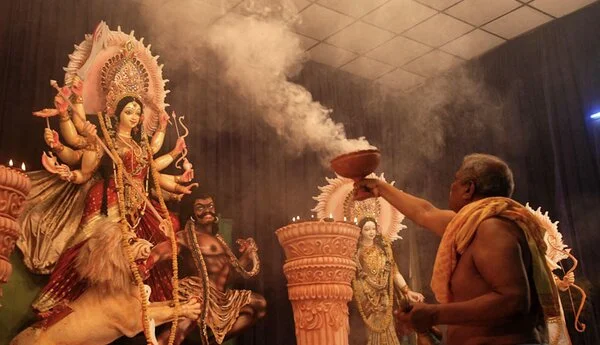Durga Puja: Five-Day-Long Celebration Begins

The grand religious festival of Durga Puja, celebrated by the Bengali Hindu community, commenced yesterday. This joyful occasion was marked by deep religious devotion.
The traditional five-day Sharadiyo Durgotsab began yesterday with the morning Kalparambho ceremony, followed by Adhibash, Amantran (invitation), and Bodhon (incarnation) in the late afternoon and evening. This marked the beginning of Maha Shasthi Tithi, which commenced at 12:31 am.
Maha Saptami
The morning Maha Saptami puja will feature the ceremonial bathing of the nabapatrika, which consists of nine plants, including a banana tree. These plants are bound together and wrapped in a white saree with red borders. This ritual involves immersing the nabapatrika in the sacred waters of the Ganges, placed next to the deity Ganesha. In certain Bengali traditions, the banana tree in the nabapatrika is referred to as ‘Kolabou’ or the banana-bride, and is considered by many as one of Lord Ganesha’s consorts.
Maha Ashtami
On the third day of Maha Ashtami on October 22, different rituals including offering of Anjali and Kumari Puja will be held in the morning and Sandhi Puja in the late afternoon or in the evening.
- Anjali: This is a general term for offering prayers to the gods and goddesses.
- Kumari Puja: This is the worship of a prepubescent girl as the living incarnation of Maa Durga. The girl is dressed in new clothes and decorated with floral ornaments. This ritual has its origins in the Puranas.
- Sandhi Puja: This is a special puja that is performed at the transition point between Ashtami and Nabami. The last 24 minutes of Ashtami and the first 24 minutes of Navami are known as ‘Sandhikkhon’.
Maha Nabami

Maha Nabami Puja will be held on the fourth day on October 23. On the fourth day of Durga Puja, Maha Nabami, there is a ritual called Dunuchi Nach.
In this ritual, people take clay pots filled with smoking charcoal in their hands and start dancing. Some people try to balance the clay pot on their heads, while others hold the pot through their teeth. Earlier, Dunuchi Nach was performed only by men, but nowadays women are also participating in this ritual.
Bijaya Dashami

On the final day of Bijaya Dashami, puja will be offered in the morning and Darpan Bisharjan will also be held. Sindoor Khela is one of the most popular parts of Durga Puja on the last day, Bijoya Dashami. It is a ritual where married women, whose husbands are still alive, play with vermilion powder.
On Dashami, after Maa Durga is given a grand farewell before she is immersed in the river water, married women offer vermilion and sweets to the goddess. Then, they playfully smear each other with vermilion. This ritual is believed to bring good fortune for their family and help their husbands live longer.
The five-day Durga Puja festival will end on Bijoya Dashami. On the last day of Durga Puja, Bijoya Dashami, the idols of Goddess Durga and her children are taken out of their earthly abode, the pandal, and immersed in a river or other body of water. This is known as Bisarjan. Bisarjan symbolizes the goddess’ return to Mount Kailash, her home with her husband Lord Shiva. It is a bittersweet day for devotees, who are sad to see the goddess go but also hopeful that she will return next year.

- Art
- Causes
- Best Offers
- Crafts
- Dance
- Drinks
- Film
- Fitness
- Food
- Игры
- Festival
- Gardening
- Health
- Главная
- Literature
- Music
- Networking
- Другое
- Party
- Religion
- Shopping
- Sports
- Theater
- Wellness



